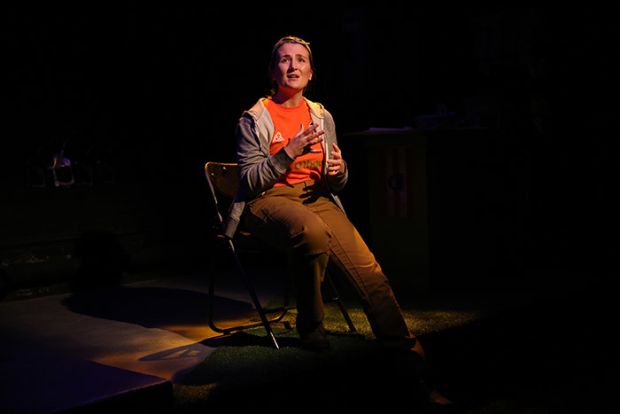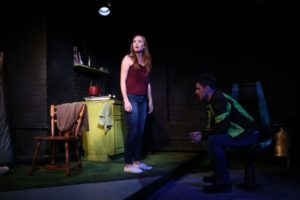
There’s a funny moment in the new parody show, Forbidden Broadway, when a spoof of The Ferryman, a play by Jez Butterworth about Northern Ireland, begins with a song. It’s sung to the tune of “How are Things in Glocca Morra?” from Finian’s Rainbow, and the lyrics are changed to “How are Things in Irish Drama?”
The answer is they are finer than fine. Everywhere you turn, there’s another Irish play, and each seems better than the last. Irish Repertory Theatre has just opened Pumpgirl by Abbie Spallen—a name new to me but not to all the prize-givers who have honored her. What a discovery she is. And what a knockout of a cast Nicola Murphy, the director, has assembled.

Like much Irish drama, Pumpgirl is written in monologues. Theatrically, structurally, these create zones of isolation reflecting each character’s “solitude” as a character calls it— the keynote of their tragic lives. Each of the three characters has a station on stage, and while one speaks, the others disappear into the darkness.
The title character (Labhaoise Magee whose accent is so authentic as to make me wish for subtitles) works at a gas station and loves the smell of petrol; Pumpgirl must get sick of being asked if she’s a man or a woman; her response is to turn her baseball cap backwards, like a “professional.”
She loves Hammy (Hamish Allan-Headley), a rough, crass customer who races cars and is married to the sad, lovely Sinead (Clare O’Malley) who eyes suddenly sparkle when she finds—or thinks she finds—love and excitement.
The challenge to the actors—a challenge already met by the playwright—is that all the other characters have to be created in our minds as they are described by each of the three: the mean women in the town, Sinead’s children, Hammy’s pals who gang rape the Pumpgirl, a “wee Romanian gypsy woman smilin’,” the empty produce market. Shawshank—who is merely spoken of—becomes a major figure in the story, as Sinead falls for him. And we also have to imagine—as they are described for us—the places themselves. It’s like having a book read to you when you can watch the characters fully alive.
There is dread as there always is in Irish drama: children who are forgotten and then led on a dangerous adventure, Pumpgirl futilely waiting for Hammy to show up, while Sinead, night after night, dreads her husband’s arrival each night, wishing she could saw the bed in half or staple the covers down the middle. She pretends to sleep while he tries to get her attention: jab, jab jab. Slurp. It is as though we’re in the bed with her.
The set design (by Yu-Hsuan Chen) makes the absolute most of the small stage as these excellent actors, in such proximity to us in this intimate theater, create a separate world of such vividness and such heartbreak.
And so things are just fine in Irish drama. If you’re a fan, don’t miss this one.
[Irish Repertory Theatre, 132 W. 22nd St., NYC] November 9-December 29, 2019; irishrep.org
